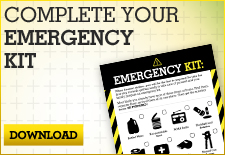
Disasters can happen… at any time. Be prepared to take action before, during and after.
Chemical and hazardous substances, if released or misused, can pose a threat to you or the environment. Chemicals may include items found around your home or in your garage. Hazardous materials may include substances that are transported on roadways, railways, waterways, and pipelines. Remember that an incident involving chemicals or hazardous materials can happen in your community through accident or intentional action, such as an act of terrorism.
Many hazardous materials do not have any odor, and may only be detected once physical symptoms like watering eyes or nausea occur. Some hazardous materials can cause death, serious injury, long‐lasting health effects, and damage to buildings and property. They can have an immediate effect (a few seconds to a few minutes) or a delayed effect (2 to 48 hours).
- Inhaling the chemical or hazardous material.
- Swallowing contaminated substances, food, water, or medication.
- Touching it or coming into contact with clothing or things that have touched the substance.
Your local fire department or emergency management agency may have additional information on chemical or hazardous materials that might impact your community.
Before
Before a chemical or hazardous materials incident, it is important to know the types of hazards that you may be exposed to in your home and community. Look for hazards that might be in your home as well as those in your community.
2 – Complete the Emergency Contacts Card and place one in your Emergency Kit.
3 – Prepare an Emergency Kit. The Emergency Kit should be easily accessible should you and your family be forced to shelter in place (stay at home) for a period of time.
- Contact your local emergency management office or fire department to understand the types of chemicals or hazardous materials that might impact your community.
- Understand evacuation routes around your home, work, school or the places you frequent.
Identify multiple evacuation options in case your first chosen route is not safe.
During
If you are directly exposed to any hazardous substance, dial 9‐1‐1. In many cases decontamination is needed within minutes of exposure to minimize health consequences. Do not leave the safety of a shelter to go outdoors to help others until authorities announce it is safe to do so. A person affected by a chemical agent requires immediate medical attention from a professional. If materials are available to safely remove a chemical from a person try to help them as much as possible; however, continue to seek help from first responders.
- Keep your body fully covered and wear gloves, socks and shoes even though these measures may offer minimal protection.
- Avoid eating or drinking any food or water that may be contaminated.
- If you are told to evacuate, do so immediately.
- In general, try to go at least one‐half mile (10 city blocks) from the incident area.
- Stay away from the incident area to minimize the risk of contamination.
- Act quickly if you have come into contact with or have been exposed to hazardous materials.
- Follow decontamination instructions from local authorities. You may be advised to take a thorough shower, or you may be advised to stay away from water and follow another procedure.
- Seek medical treatment for unusual symptoms as soon as possible.
- Place exposed clothing and shoes in tightly sealed containers. Do not allow them to contact other materials. Call local authorities to find out about proper disposal.
- Advise everyone who comes into contact with you that you may have been exposed to a hazardous material.
After a chemical or hazardous materials incident, it is important to remember that your environment may still contain toxins. Local law enforcement and emergency management professionals will advise you of any actions you may need to take to clean‐up your property.
- Return home only when authorities say it is safe. Open windows and vents and turn on fans to provide ventilation.
- Find out from local authorities how to clean up your land and property.
- Report any lingering vapors or other hazards to your local emergency services office.



